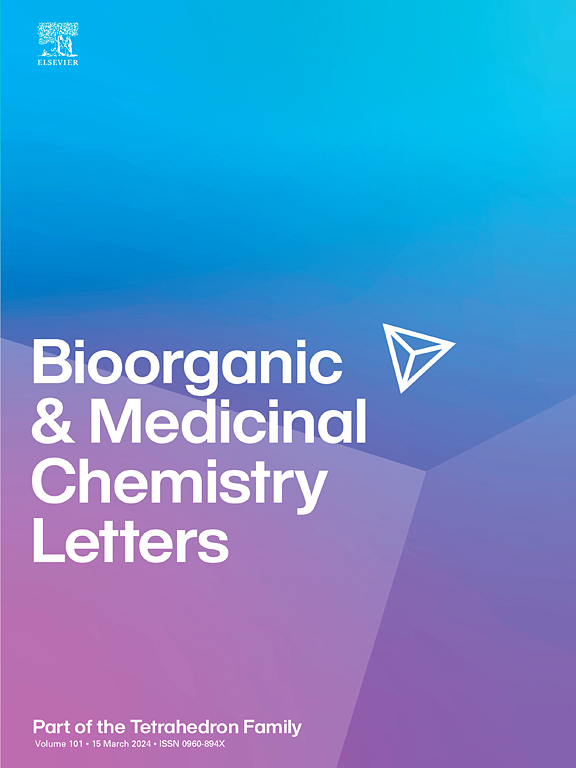Synthesis of Isosteviol derivatives as potential anticancer agents, especially for ovarian Cancer: In vitro cytotoxicity, cell cycle arrest, network pharmacology and molecular docking study
IF 2.5
4区 医学
Q3 CHEMISTRY, MEDICINAL
引用次数: 0
Abstract
Isosteviol is a tetracyclic diterpenoid from the hydrolysis of steviosidic acid, it exhibits a moderate inhibitory impact on tumor proliferation across various cancer types. Herein, we improved antitumor efficacy of isosteviol by modifying its reactive groups at C-16 and C-19 positions. A series of isosteviol derivatives 2–17, were synthesized and characterized. Their anti-proliferative activities were evaluated in three human cancer cell lines (HCT116, SKOV3 and HepG2) by CCK-8 assay. The results showed that derivative 10 has strong cancer cell inhibitory activities (with IC50 = 24.98 ± 1.82 μM for HCT116, IC50 = 26.15 ± 0.05 μM for SKOV3 and IC50 = 23.09 ± 0.31 μM for HepG2 cells). Accordingly, structure-activity relationships (SARs) of these isosteviol derivatives in ovarian cancer SKOV3 cells were discussed in detail. Moreover, derivative 10 has concentration-dependent cell cycle arrest at S-G2/M phases in SKOV3 cells, and it could greatly induce apoptosis. In addition, the targets of isosteviol against ovarian cancer were predicted and analyzed via network pharmacology. Then, molecular docking analysis showed that derivative 10 could interact with HSP90AA1 through its LYS-58 residues (docking energy: −8.96 kal/mol). The results suggested that derivative 10 might be employed as a promising drug candidate for anticancer chemotherapy.

异甜菊醇衍生物作为潜在抗癌药物的合成,特别是卵巢癌:体外细胞毒性、细胞周期阻滞、网络药理学和分子对接研究
异甜菊糖醇是甜菊糖酸水解而成的四环二萜类化合物,它对多种癌症类型的肿瘤增殖具有适度的抑制作用。本研究通过对异甜菊醇C-16和C-19位点的活性基团进行修饰,提高了异甜菊醇的抗肿瘤作用。合成了一系列异甜菊醇衍生物2-17并对其进行了表征。采用CCK-8法对三种人癌细胞(HCT116、SKOV3和HepG2)的抗增殖活性进行了评价。结果表明,衍生物10对HCT116、SKOV3和HepG2的IC50分别为24.98±1.82 μM、26.15±0.05 μM和23.09±0.31 μM,具有较强的抑癌活性。因此,我们详细讨论了这些异甜菊醇衍生物在卵巢癌SKOV3细胞中的构效关系。衍生物10在SKOV3细胞中具有浓度依赖性的S-G2/M期细胞周期阻滞作用,可显著诱导细胞凋亡。此外,通过网络药理学对异甜菊醇抗卵巢癌的靶点进行了预测和分析。然后,分子对接分析表明,衍生物10可以通过LYS-58残基与HSP90AA1相互作用(对接能:−8.96 kal/mol)。结果表明,衍生物10可能是一种很有前途的抗癌化疗候选药物。
本文章由计算机程序翻译,如有差异,请以英文原文为准。
求助全文
约1分钟内获得全文
求助全文
来源期刊
CiteScore
5.70
自引率
3.70%
发文量
463
审稿时长
27 days
期刊介绍:
Bioorganic & Medicinal Chemistry Letters presents preliminary experimental or theoretical research results of outstanding significance and timeliness on all aspects of science at the interface of chemistry and biology and on major advances in drug design and development. The journal publishes articles in the form of communications reporting experimental or theoretical results of special interest, and strives to provide maximum dissemination to a large, international audience.

 求助内容:
求助内容: 应助结果提醒方式:
应助结果提醒方式:


